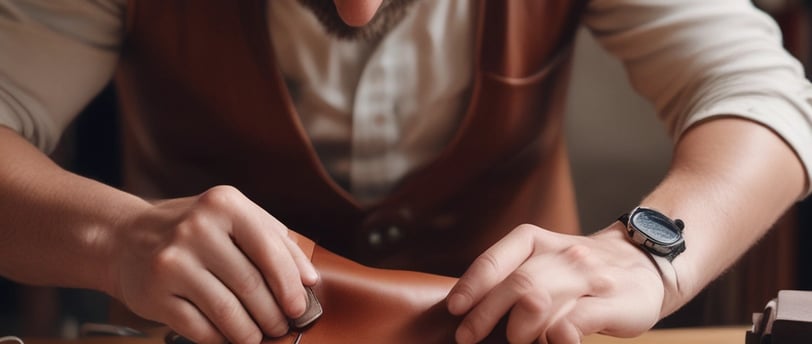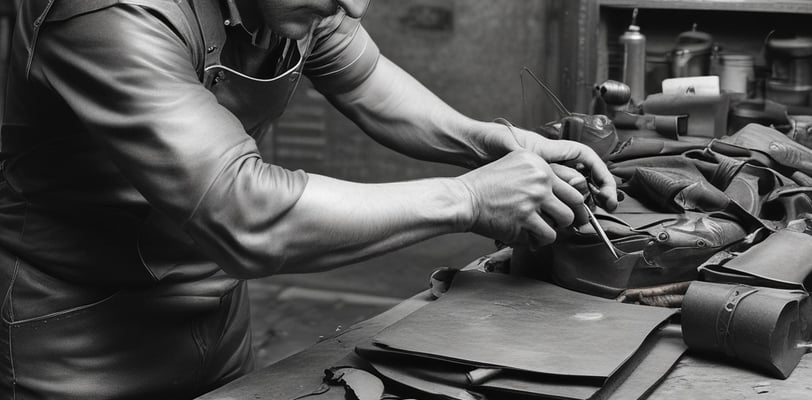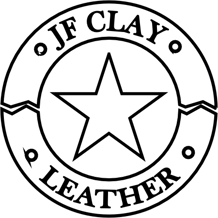Crafted leather goods at unbeatable prices!
Leather Topics
3/29/20254 min read


Types of Leather: An Overview
Leather is a material that has been utilized for various applications ranging from clothing to furniture. It’s crucial to understand the different types of leather available, as they each possess unique characteristics that influence their usability and longevity. The major varieties of leather include full-grain, top-grain, genuine, and bonded leather.
Full-Grain and Top-Grain Leather
Full-grain leather is considered the highest quality leather available. It retains the natural grain of the hide, with its complete structure. This makes it not only robust but also gives it a beautiful, aged appearance as it develops a patina over time. It is ideal for high-end products such as luxury bags, shoes, and furniture.
I use vegetable tanned top/full grain, dyed vegetable tanned, and sometimes chrome tanned leathers on my products. I do not use genuine or bonded leathers as they are of very low quality.
On the other hand, top-grain leather is slightly less durable as it has been sanded down to remove imperfections, and as a result, it loses some of its natural strength. Nonetheless, top-grain leather has a more uniform look, making it a popular choice for wallets and belts. Both types are great for crafting long-lasting goods, however, full-grain leather typically stands the test of time better.
Genuine and Bonded Leather
Genuine leather is a term often used to describe lower-quality leather made from the leftovers of high-quality leather production. While it is more affordable, it does not possess the durability or distinct characteristics found in full-grain or top-grain leather. Often used in less costly items like furniture and fashion accessories, genuine leather can still offer a stylish appearance.
Bonded leather, however, is the least durable of the options. It is composed of leftover scraps of leather that are glued together and then topped with a synthetic layer. While it is the most budget-friendly option, bonded leather is prone to wear and tear, making it less suitable for products that require longevity.
Vegetable Tanned vs. Chrome Tanned Leather
Another critical distinction in the world of leather is the tanning process. Vegetable-tanned leather, as the name implies, is tanned using natural vegetable extracts. This method is environmentally friendly and creates leather that ages beautifully, developing character over time. It is often used for high-end leather goods, belts, and bags because it maintains its shape and develops a unique patina.
Conversely, chrome-tanned leather is treated with chromium salts, making it supple and pliable. This process allows for a quicker production turnaround but can sometimes lead to environmental concerns, as chromium is a toxic substance. Chrome-tanned leather is ideal for everyday items that require flexibility, such as shoes and jackets. While both tanning methods offer distinct advantages, the choice ultimately depends on the specific needs of the consumer.
In summary, understanding the various types of leather—full-grain, top-grain, genuine, and bonded—along with the differences between vegetable-tanned and chrome-tanned leather, is essential for anyone looking to make informed choices about leather products. Each type has its advantages and disadvantages, catering to different preferences and uses. Whether you seek durability, aesthetic appeal, or budget-friendly options, there is always a leather type that suits your needs.
How to repair damaged leather:
Leather is a durable and long-lasting material, but with time and use, it can become damaged. Whether you've got a scuffed leather bag or a ripped leather sofa, repairing the damage can help extend the life of your item and restore its beauty. Here are some common types of damages to leather items and how to repair them:
Scuffs and Scratches: Over time, leather can become scuffed or scratched from everyday use. To fix this, you'll need a soft-bristled brush, leather cleaner, leather conditioner, and a microfiber cloth. Start by brushing away any dirt or debris with the soft-bristled brush. Then, apply the leather cleaner to the scuffed area according to the manufacturer's instructions. Once cleaned, apply a leather conditioner to help restore the leather's natural oils and prevent further damage. Finally, use a microfiber cloth to buff the area until it looks smooth and shiny again.
Rips and Tears: Small rips or tears can often be repaired with a little patience and the right tools. You'll need a pair of sharp scissors, leather glue, sandpaper, a piece of matching leather, and a leather repair kit (which includes a needle, thread, and awl). First, clean the area around the rip or tear to remove any dirt or debris. Then, using the awl, carefully poke small holes along each side of the damage, about 1/4 inch apart. Next, cut a piece of leather that is slightly larger than the damaged area. Sand the edges of this patch so they are smooth and even. Apply leather glue to both the damaged area and the patch, then press the patch onto the tear, making sure it's aligned properly. Allow the glue to dry according to the manufacturer's instructions. Once the glue is dry, use a needle and thread from the repair kit to stitch around the edges of the patch, securing it in place.
Cracks: Over time, leather can become brittle and crack. To fix this, you'll need a leather conditioner, a microfiber cloth, and possibly a leather filler or wax if the cracks are deep. Start by applying the leather conditioner to the cracked area according to the manufacturer's instructions. This will help restore some of the leather's natural oils and make it more pliable. If the crack is shallow, you may be able to gently rub the edges together until they seal. However, if the crack is deep, you might need to use a leather filler or wax to fill in the gap. Apply the filler or wax according to the manufacturer's instructions and allow it to dry completely before buffing the area with a microfiber cloth.
Stains: Accidents happen, and sometimes your leather items can become stained. To remove stains, you'll need a leather cleaner specifically designed for the type of stain (e.g., water-based cleaner for water-based stains). Follow the manufacturer's instructions on how to apply the cleaner and allow it to sit for the recommended amount of time before wiping away with a microfiber cloth. If the stain is particularly stubborn, you may need to repeat this process several times until the stain is completely gone.
Remember that repairing damaged leather items takes patience and practice. It's always best to start small and work your way up to more complex repairs as you gain confidence in your skills.


